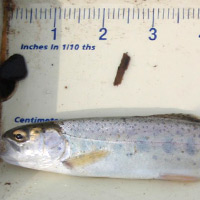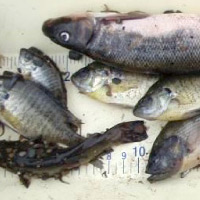
PROJECTS
The Fishery Foundation of California's Current Projects
Summary of Calaveras River and Mormon Sough/ Diverting canal
Fish Stranding and Relocation
Events February 17-19, 2010
During (Feb.17-19) pre-project, post high flow event monitoring for the Budiselich Barrier Removal project, Fishery Foundation of California (FFC) discovered a total of 34 live and 3 dead O.mykiss, one delta smelt (Hypomesus transpacificus) and hundreds of other fish of various species (details to follow) in the Calaveras diverting canal near Wilson Way. The delta smelt was turned over to FWS biologist Lori Smith at the collection site. Live O.mykiss were relocated downstream in the Calaveras River and other fish were returned to the pools after processing.
At approximately 4:30 in the afternoon on February 17, 2010, FFC discovered four O.mykiss stranded in a hydraulically disconnected shallow pool (Figure 1) in the diverting canal upstream of the confluence with the Old Calaveras channel (about parallel with the telephone pole near the house on the north levee). The weather was sunny and daytime temperatures reached 70 oF. The stranding pool was about 8 feet long and 4 feet wide with a maximum depth of 7 inches. Water temperature was 66 oF. One partially eaten O.mykiss carcass was also discovered on the dry channel bed nearby (Figure 2). Additionally, 7 Bluegill (Lepomis macrochirus),1 Green Sunfish (Lepomis cyanellus), 1 Sacramento Sucker (Ptychocheilus grandis) and 4 Inland Silverside (Menidia beryllina) and one Black Bullhead (Ameiurus melas) were observed (Figure 3) and returned to the pool. DFG, SEWD and USFWS AFRP were notified and FFC proceeded to collect, process and relocate the four O. mykiss as per permit #1416 issued to FFC by NMFS under section 10 of the ESA. All O. mykiss were immediately placed in aerated five gallon buckets (Figure 4). Fork lengths were estimated and smolt stages noted (Figures 5-6), all four O. mykiss were classified as silvery parr (Table 1). During this time DFG Warden Lori Oldfather arrived at the site just before dark to photo document the event and offer assistance. After leaving the site at approximately 6:30pm, Kari Burr (FFC) was joined by Dr. Stacy Luthy (UOP) and they proceeded to a release location downstream in the Calaveras River near Brookside housing development. The fish were released from a dock on the Darrah property opposite Brookside in a tidal reach of the Calaveras River about one quarter mile from the confluence with the San Joaquin River/Stockton Deep Water Ship Channel. All fish were in good condition and actively swam away.
February 18, 2010
FFC resumed the stranding survey and relocation effort at 8:00am on February 18, 2010. The weather was partly cloudy and slightly cooler than the day before. We returned to the site where four O.mykiss were discovered the previous day and found it completely dewatered. All non-salmonids from the previous day were dead or dying on the dry channel bed and one additional partially eaten O.mykiss carcass was observed. Three additional hydraulically isolated pools in the Diverting Canal between the Central traction Rail Bridge upstream of Wilson Way and the confluence with the old Calaveras channel were identified for seining.
The first pool, located about 400 meters downstream of Wilson Way was 120 feet long, 35 feet wide and had an average depth of about 2 feet. The water temperature was 55 oF. Two seine hauls at 9:15am yielded 3 threadfin shad (Dorosoma petenense), 9 bluegill, 2 inland silversides, and 12 mosquitofish (Gambusia affinis). Fork lengths were estimated and fish were returned to the pool.
The second pool was located at the confluence with the Old Calaveras and extended downstream (Figure 7) (Figure 8). Length was 90 feet, width 28 feet and average depth was about 2 feet. Water temperature was 55-56 oF. Three seine hauls were made at beginning at 11:00am yielding: 76 bluegill, 6 carp (Cyprinus carpio), 81 Golden Shiners (Notemigonus crysoleucus), 9 inland silversides, 4 Largemouth bass (Micropterus salmoides), 41 Threadfin shad, and 18 O.mykiss. An additional O.mykiss was netted in a small stranding pool just downstream of pool 2. Fish were processed and 19 O.mykiss (5 smolts and 14 silvery parr) were relocated to The Calaveras River and released at 1:30pm in good condition at the same release point used the previous day.
The third pool (Figure 9) was located just upstream of the RR Bridge near the cement stormwater culvert. Pool 3 was 73feet long, 16.5 feet wide and average depth was 1 foot. Water temperature was 66 oF. One seine haul at 2:30 yielded 10 Threadfin shad and one bluegill. Fish were processed and returned to the pool.
FFC surveyed upstream to check for more isolated pools and noted several more sites to seine between Wilson Way and the Central Traction Railroad bridge. We then checked Budiselich for hydraulic disconnection and found it still connected at the Hwy 99 Bridge.
February 19, 2010
FFC resumed the stranding survey and relocation effort at 9:00am on February 18, 2010. The weather was cloudy and cool with a light sprinkle. Budiselich was checked and was still connected, but near disconnection just downstream of Hwy 99. There appeared to be a few points of disconnection between Cherokee bridge and the Central Traction RR bridge but the most significant dewatering occurred downstream near Wilson Way therefore efforts were focused in that area.
Four new pools were identified for seining, one upstream of Wilson way and three downstream. Pools one and three from the previous day were seined again to ensure no O.mykiss were missed.
The first pool was located about 300 meters downstream of the Central Traction Rail Bridge and measured 60 feet long and 9feet wide, average depth 0.5 feet. At 11:05am the water temperature
was 57 oF. Two seine hauls yielded 275 bluegill, 9 carp, 27 black bullhead, 5 golden shiner, 11 inland silverside, 14 Pumpkinseed (Leopomis gibbosus) 4 redear sunfish, 1 Sacramento sucker, 2 smallmouth bass and 6 green sunfish (Figure 10).
Upstream of the first pool about 140 meters from the Central Traction RR bridge was a freshly dewatered area where 60 bluegill, 4 mosquitofish several bullfrog tadpoles and four catfish were observed nearby (Figure 11).
The second pool was about 300 meters downstream from Wilson Way, 80 feet long 10 feet wide and 0.5 feet deep. Water temperature was 57 oF. One haul at 10:30am brought only three mosquitofish, a few tadpoles and a crayfish.
At about 12:00pm a pool seined the previous day approximately 400 meters downstream of Wilson Way had diminished in size and was seined again. The pool was now 30 feet long, 10 feet wide and 0.5 feet average depth. (Figure 12) Water temperature was 59 oF. Two passes were made with the seine and one delta smelt (Hypomesus transpacificus) was hauled in along with one inland silverside, one threadfin shad, one brown bullhead, 22 bluegill and 16 mosquitofish. FFC contacted FWS who sent biologist Lori Smith to collect the fish. The delta smelt (Figure 13) was kept in an aerated five gallon bucket until Ms. Smith arrived and positively identified the fish then transported it off site. Also present was Jim Inman from FISHBIO who contacted Erin Strange at NMFS and Kevin Kauffman (SEWD).
The third new pool located 200 meters downstream of Wilson Way, was 105 feet long, 30 feet wide and had an average depth of one foot. Water temperature was 61 oF and one seine haul at 1:45pm yielded; one O. mykiss, 19 bluegill, 4 redear sunfish, 3 carp, 34 golden shiner, 3 largemouth bass and 2 brown bullhead.
The fourth new pool was located 100 meters downstream of Wison Way. It was 80 feet long 12 feet wide and average depth was 0.5’. Water temperature was 61 oF at 2:45pm and two seine hauls yielded; 12 O. mykiss (9 silvery parr & 3 smolts), 154 bluegill, 31 redear sunfish, 19 golden shiner and one largmouth bass. One O.mykiss (silvery parr) carcass was found completely out of water adjacent to the site.
A repeat seine was conducted at 1:40pm in the pool at the confluence (which was seined the previous day) with the Old Calaveras and one more O. mykiss (silvery parr) was discovered. Water temperature was 58 oF and average depth was 2.5 feet. Two O. mykiss were turned over to DFG Warden Lori Oldfather at the request of Captain DeAnda. The other 11 O.mykiss rescued were relocated to the Calaveras River release site on the Darrah property and released in good condition at 3:20pm (Figure 14-15).
FFC returned to upstream to check a pool between the footbridge downstream of the confluence and West Lane. Considering the pool’s proximity to tidewater and the rain forecast for Saturday and Sunday, FFC decided not to seine as is likely to reconnect over the next two days which would allow fish to migrate out. FFC will assess conditions on Monday February 21, 2010 to determine if more surveys are needed.



